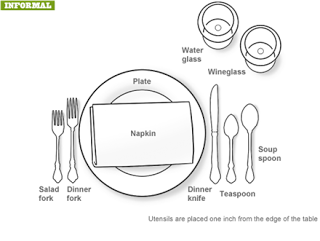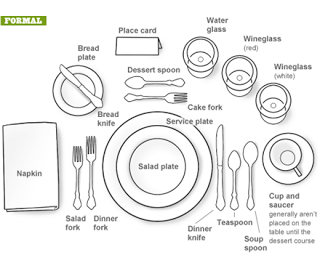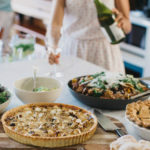With some very special holidays right around the corner, you might be hosting a few social gatherings at your house. One of the most feared tasks to do when planning a dinner party is setting the table. Many people initially think that properly setting the table is extremely difficult and oftentimes tricky.
I’m here to tell you that it’s not. I love setting my table for dinner parties, especially when cute, seasonal decorations are involved…and you should too!
There is no single way to set a table correctly; however, there are a few things you should keep in mind: make sure the settings are functional and pleasing to the eye. Many of us are familiar with casual and informal settings because these allows us the flexibility to mix and match dinnerware patterns, flatware and glassware. It’s the formal table that tends to be a bit more rigid and symmetrical.
In every scenario, utensils are placed starting form the outer left and right edge of the table setting, in the order that the dishes are served. The idea behind this arrangement is that you “eat your way into” the place setting. As my Dad always said, “Work your way outside in.” For example, salads and soups typically are served as the precursor to the main course, thus their associated utensils are placed on the outer left and right edges of the table setting.
Another mistake I’ve seen at tables is mass confusion regarding glasses and bread plates. Oftentimes I find myself seated at tables where someone goes around assigning water glasses so as not to be confuse your glass with your neighbor’s glass. It’s always nice to keep in mind that drinking glasses will always be to the right of your plate and the bread plate to your left.
Table Setting 101: Basics and Guidelines
Below are examples of various table settings, accompanied by examples of meals that are typically served under each table setting:
Informal Dinner Place Setting Guide
Typical setting includes:
- Dinner plate

- Salad plate
- Bread and butter plate
- Bread and butter knife
- Dinner fork
- Salad fork
- Dinner knife
- Salad knife
- Water glass
- Wine glass
- Dinner napkin
Meal:
- First course (soup, fruit, shellfish or appetizer)
- Salad
- Entree (includes vegetable)
- Dessert
Formal Dinner Place Setting Guide
Typical setting includes:
- Name (place card)
- Soup bowl

- Plate
- Salad fork
- Dinner fork
- Service plate
- Dinner plate
- Bread and butter plate
- Bread and butter knife
- Soup bowl
- Salad knife
- Dinner knife
- Napkin
- Soup spoon
- Water glass
- White wine glass
- Red wine glass
Meal:
- First course could include appetizer (e.g., shrimp cocktail)
- Second course – soup (e.g., lobster bisque)
- Salad (e.g., Caesar salad)
- Entree (includes vegetable) – Fish, beef, poultry or pork
- Dessert (e.g., cheesecake)
Note: A sorbet to cleanse the palate would be offered between the salad and the entree.
And if you’re really in the mood to impress, you should check out this napkin folding site. It’s filled with step-by-step instructions and pictures on how to fold a napkin in all sorts of different ways.
Overwhelmed still? Well, just always be sure that forks are always to the left of the plate and knives and spoons to the right. Once you have this down, everything else should come as easy as pie!







Leave a Reply